People
‘I Embrace Whatever Label Is Attached to Me’: Activist and Artist Gregg Bordowitz on Identity Politics and Why the AIDS Crisis Is Only Beginning
We spoke with the artist on the occasion of a 30-year retrospective of his work at MoMA PS1.
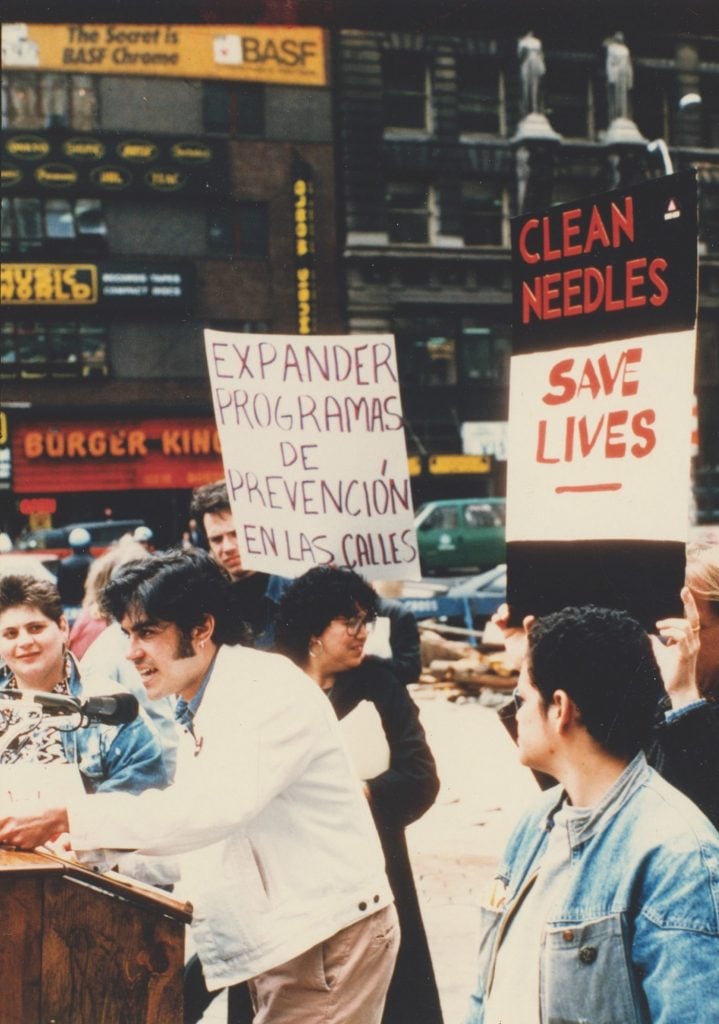
We spoke with the artist on the occasion of a 30-year retrospective of his work at MoMA PS1.

Pac Pobric

They could be six different people, some older, some younger. One seems tired; another one is entirely worn out. A third one strikes a pose. Maybe he’s channeling James Dean. One of them looks like an artist, if a person’s face could say, I’m an artist.
But they’re not different people. The six drawings, arranged neatly in a row at MoMA PS1, are self-portraits by Gregg Bordowitz done before a mirror over the course of 11 days in October 1996, the year that protease inhibitors, a group of antiviral drugs, became available as an HIV treatment.
Gregg Bordowitz, who is queer and has AIDS, is a writer and poet, performer, visual artist, filmmaker, and activist. He’s also a son, a friend, a teacher at the School of the Art Institute of Chicago, a native of Queens, a voracious reader, a practicing Jew—he is many things.
For 30 years, since he first began to use visual media as a tool for AIDS activism as a member of ACT UP, he’s been stressing this point: that each of us is multiple, and never simply one.
On the occasion of the artist’s stirring retrospective, “I Wanna Be Well,” now at MoMA PS1 (through October 11), we spoke with Bordowitz about identity, the successes and ramifications of the AIDS activist movement, and how art can build coalitions.
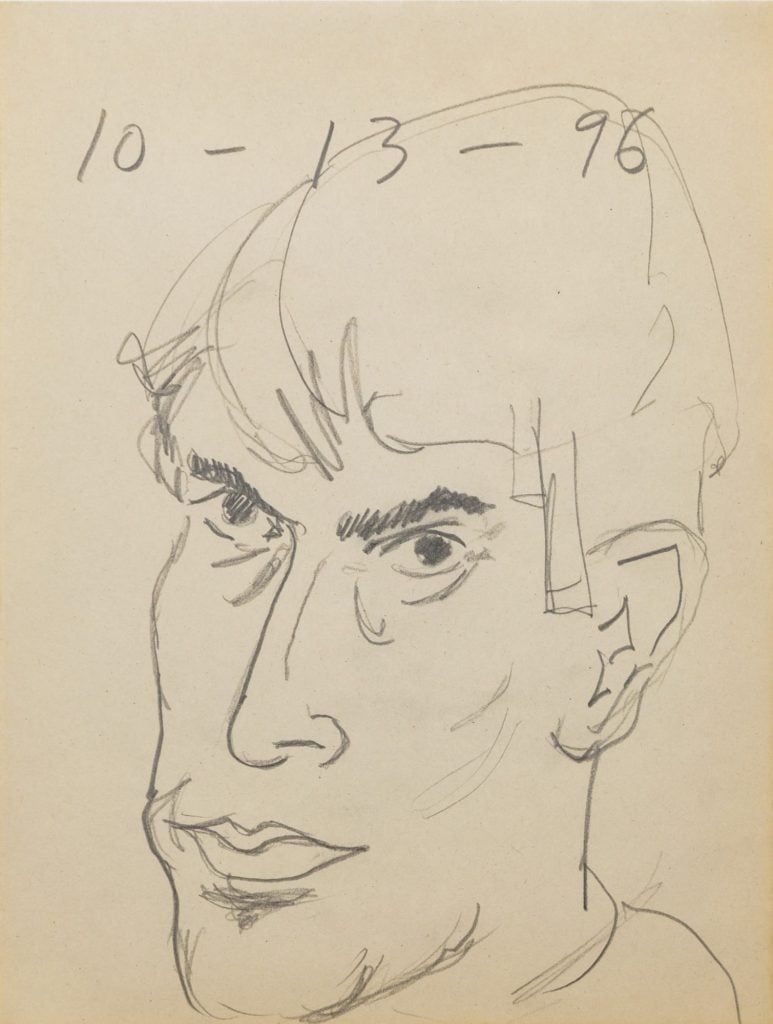
One of Gregg Bordowitz’s self-portraits in mirror (1996). Throughout his career as an activist, artist, filmmaker, and performer, Bordowitz has stressed that each of us has many complex identities. Courtesy of the artist.
Gregg, you have many audiences: the students you teach, the people who visit your exhibitions, those who reads your books and poems. Do you ever have an ideal audience in mind?
I’m very fortunate that I’m part of many different groups, which in ways represent the very many parts of myself. I’m not talking in a pathological sense. I believe that we are multiple selves in a singular self. All my life, mobility has been very important. I enjoy moving between the boundaries of a so-called “art world” and a so-called “activist world” and the so-called “academic world.” All those meet like overlapping Venn diagrams. When I walk into the Poetry Project, people see me as a poet. When I walk into a film festival, people see me as a filmmaker. When I publish an article, people encounter me as a writer. I’m fine with that. I haven’t spent a tremendous amount of energy trying to have all those modes of presentation fit under one banner.
But the retrospective has been a wonderful experience for me, because I have walked through the show with many different people from many different parts of my life: people I’ve known for 30 years, new friends, artists, people I met in activist contexts, in academia, in schul. And this may sound kind of heavy, but for the first time in my life, I feel like the many selves of my singular self can talk to and among each other. The retrospective has given me the opportunity to see that there is actually a structural integrity to my various selves.
Is it fair to say you don’t try to control how you are interpreted?
Yes, absolutely. I’m not shy about identities. I’m queer person with AIDS. If there’s anything that does tie my work together, it’s an abiding concern with LGBTQ, HIV, and healthcare issues. My ideal notion of identity politics has meant embracing whatever labels are attached to me. To the extent that so many labels accumulate, the structure of the self falls apart. That’s the aim of identity politics for me—that whatever names we attach to ourselves be considered provisional and impoverished in relationship to the complexity of who we are.
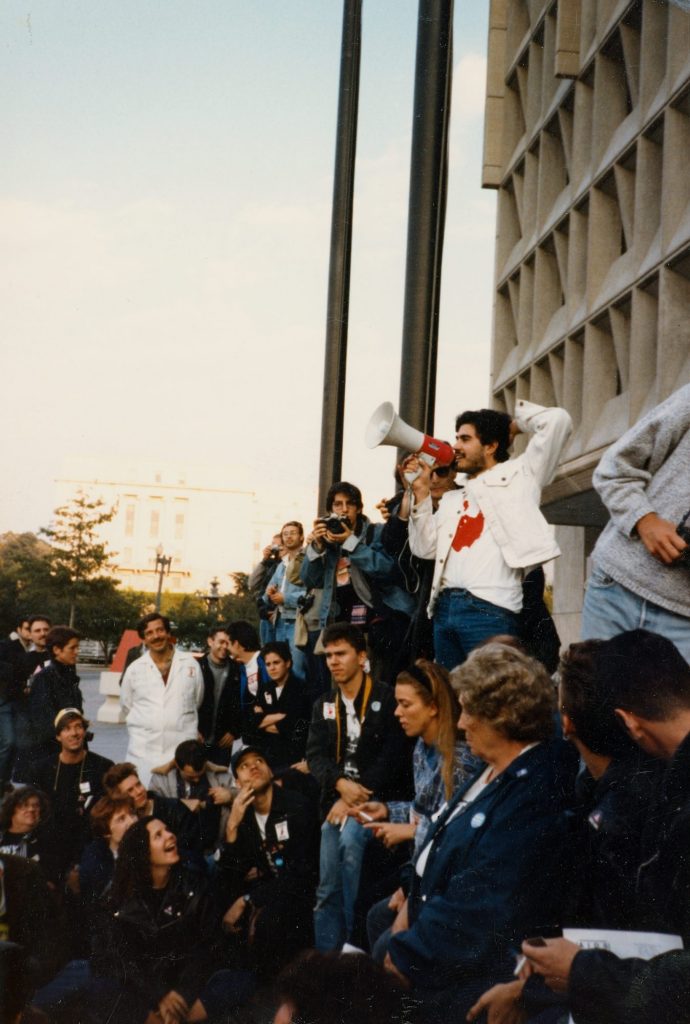
Gregg Bordowitz with a megaphone addressing a crowd of protestors in front of the Food and Drug Administration in 1988. Several people are laughing in the picture, and a sense of humor—sometimes a very dark one—hovers over his MoMA PS1 retrospective. Courtesy the artist.
I ask because, to my understanding, part of what was essential about the AIDS movement in the 1980s was that people with AIDS got to define themselves, as opposed to allowing someone else to decide the narrative.
A lot of my work started under the pressure of the culture wars of the ’80s. I was—and am—responding to the intense homophobia and stigma that people with HIV had to face. But rather than take up a defensive position, me and many of my colleagues took an offensive position: We are complex. We are many. We are multiple selves within a singular self.
How do you respond to critics of today’s activist movements who say its language is wrong? The soft version of that argument is that terms like “heteropatriarchy” don’t connect with most people, and therefore don’t work politically, and the hard version, which Andrew Sullivan voiced in a recent article, is that these terms demand orthodoxy. Meaning, if you don’t use this language, you’re part of the problem.
These criticisms are not new. We faced them in the ’80s. We had internal debates about all the criticisms you listed. I actually think that’s a testament to the health of a discussion, when it happens among activists. When it’s weaponized by senators or lawmakers, that’s a different story. But all of these terms are up for debate. When you’re in an emergency, all modes of address are needed.
I think behind the hard criticism, there’s a censoring ideological impulse. Whenever we’re talking about struggle, we’re talking about the struggle to articulate. I don’t see how you do that without varying languages. Personally, I’m deeply invested in theory, because it teaches me how to make novel formulations.
Speaking of language, it struck me how much remained unsaid in the work at PS1. In one of your Portraits of People Living With HIV (1992–95), you interview Stephen de Francesco, who worked at the time at the Gay Men’s Health Crisis. He says that all AIDS activists want to be saviors, and that anything short of absolute success is failure. What he doesn’t say, but implies, is that you’re dealing with failure every day as more and more people die.
I think what you’re noticing is that so much of our experience exceeds articulation. The lesson of poetry is that the silences, the gaps, the breaks—what exists between the lines—signify as much as the letters on the page. When something is not said, it has to do with the person I’m interviewing reaching a limit in their ability to describe what’s actually happening to us. Emotions are messy. They don’t neatly fit into words. They’re often cloud-like, and pass through each other. The best I can do as an artist is to be attuned to the quality of emotions, and allow them to exist. My notion of art departs from any idea of communication as a clear transmission from sender to receiver. There’s always noise, and I’m interested in that noise. I very much admire John Cage. When he walked into the sound-tight anechoic chamber [that inspired his composition 4’33”], he heard his own heartbeat. You can’t ever truly hear silence.
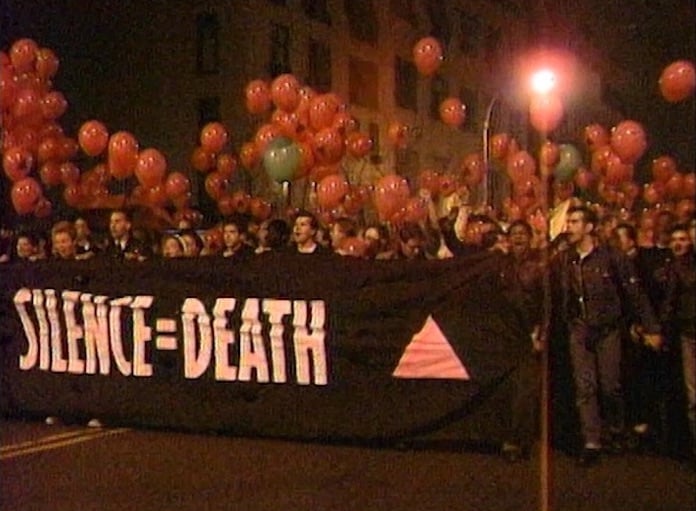
Silence = Death was originally conceived by the activists Avram Finkelstein, Brian Howard, Oliver Johnston, Charles Kreloff, Chris Lione, and Jorge Socarrás. This image is a still from Gregg Bordowitz’s film Fast Trip, Long Drop (1993), the work he says he is proudest of. Courtesy the artist and Video Data Bank at the School of the Art Institute of Chicago.
That’s especially interesting to me in relation to the most powerful phrase of the AIDS movement Silence = Death.
That slogan was a brilliant formulation. It immediately transmitted the message that we have to talk about AIDS. But, like everything else, it has to be understood in context. At the time, there was already much discussion about AIDS as a threat to the fictional general public. So there already was speech. The silence we’re referring to is that of the people who are directly affected by the disease. At that juncture in our fight, everyone was speaking for us. The entire discussion was organized around an audience that was presumed to be HIV negative, and far removed from the groups most affected. That was a lie, a murderous lie. So Silence = Death was really the origin of our efforts to have a voice.
That brings me back to what you said a moment ago about theory, and how it helps you articulate new ideas. But it can also let you down, right? There’s a moment in your film Fast Trip, Long Drop (1993) in which you—or maybe it’s an alter ego—are standing in front of bookshelves in your apartment saying, “I’ve read all these books and they’ve taught me nothing about how to deal with this crisis I’m living through.”
I think there are limits to knowledge, and especially to self-knowledge. We can’t see ourselves. We only glimpse ourselves as if we’re a stranger turning a corner. You never seeing your whole self. You look in the bathroom mirror and you see a portrait of yourself from your shoulders up. So we need art, we need poetry, we need theory to externalize our thoughts, which we find in other people’s thought. That enriches us. You know, I do not understand the dislike of theory, just like I don’t know how anyone can dislike poetry.
You’re obviously a fan of books. Part of the PS1 show is a library of hundreds of your personal titles.
The library became an object because I realized it was a portrait. I also thought of it as the footnotes to the show, because that’s the library from which I drew to make many of my works. It’s my library from 1986 to 2013. It’s a very specific date-bound library. When I look at it, I see a record of my reading life. But it’s also a record of many people’s reading lives. I enjoy going to people’s houses, looking at their books, and seeing whole portions of our libraries reproduced in our houses.
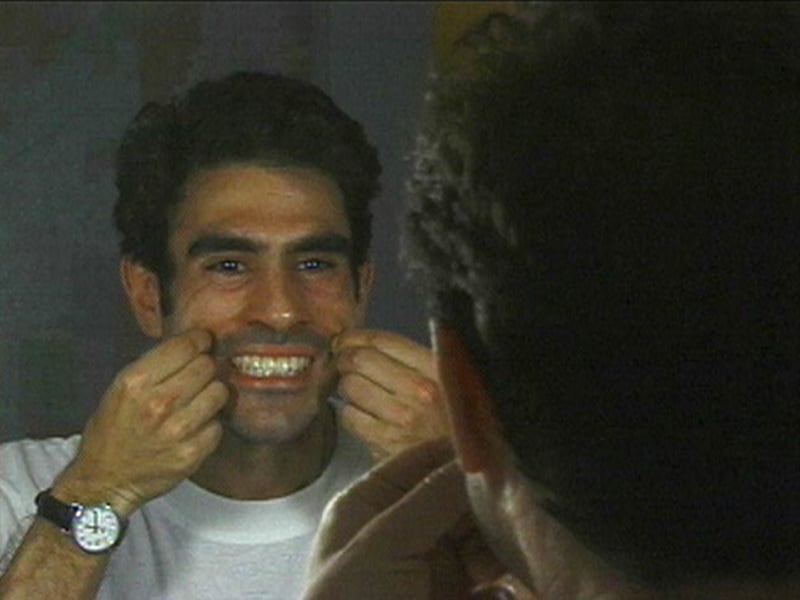
In several of his films, Gregg Bordowitz uses mirrors as a device to address both his audiences and himself. This still is from Habit (2001). Courtesy the artist and Video Data Bank at the School of the Art Institute of Chicago.
You’ve just reminded me of two moments, one in Fast Trip, Long Drop, and another in one of your Portraits of People Living With HIV, in which you’re looking into a mirror, shaving, and speaking aloud. Who are you talking to in those moments? Yourself? Someone else?
It’s a method I use in my work, and I’ve written books this way. I like to imagine different people, alive and dead, friends, lovers, acquaintances, perfect strangers. How would it sound if I said this to my mother? How would it sound if I said this to someone I just met in a bar? How would it sound if I said this to an old friend? That’s what’s going through my mind. That accounts for the differences in address. If you look at those monologues, they shift tonally from sentence to sentence. I’m also trying to explain things to myself, addressing different aspects of myself.
You mentioned recently in another interview that people with AIDS were once pariahs, and now they’re treated as a marketing demographic, as consumers of drugs. Much of that is due to the activist movements you were part of. What gets lost in that success?
It returns to your question about audience. I make work for constituencies, not for demographics. The general public is a fiction of demographics. People with AIDS were stigmatized and rendered outside the general public when homophobic lawmakers and others, out of fear and disgust, placed people with HIV on the margins of society, rather than embrace us as part of society. We’re your children, we’re your brothers and sisters, we’re your cousins. We are you.
So I make work for constituencies because I think the most radical thing art can do is bring together people who don’t understand themselves as part of the same audience. In other words, I think the most powerful potential for art is to create new audiences of people that never imagine themselves in the same room.
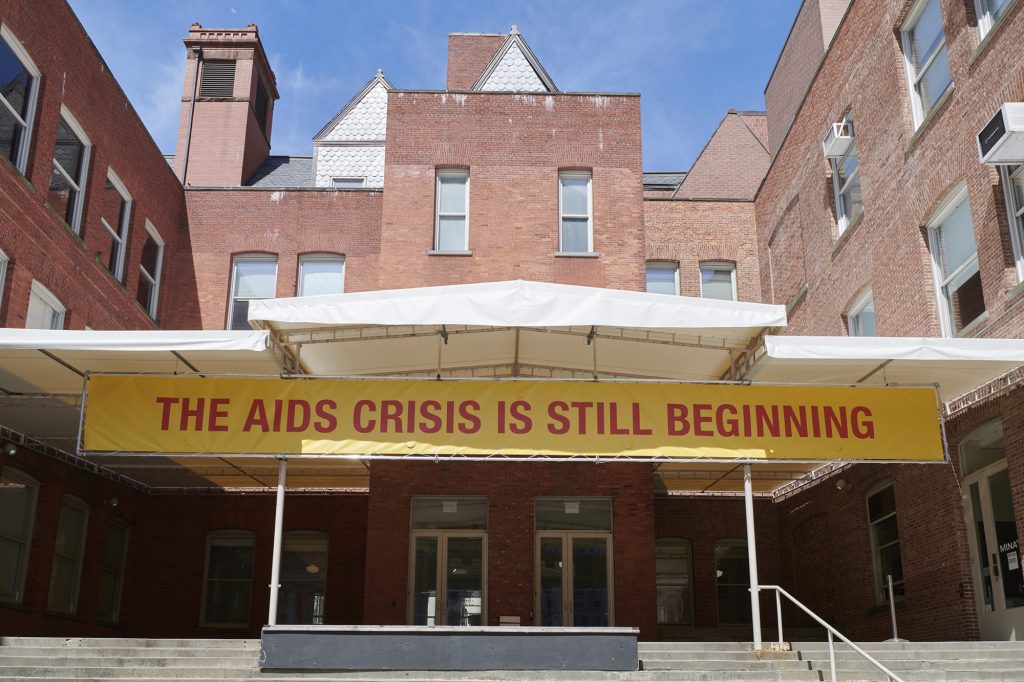
The banner leading up to MoMA PS1. Around 36 million people worldwide have the HIV virus. Fewer than half of them have access to life-saving drugs. Gregg Bordowitz, The AIDS Crisis is Still Beginning (2021). Image courtesy MoMA PS1. Photo: Kyle Knodell.
The art angle of that I understand, but let me press you on the political ramifications of your success. One of the performers you document in your film some aspect of a shared lifestyle (1986) sarcastically says something like, “Now we have gay Republicans. Woohoo!” What I’m asking is, was there any way to avoid that result if you were going to succeed in your activism?
Well, let me break that down. “The AIDS crisis is still beginning” is a banner at the front of PS1. It’s an awkward locution. “Still beginning” is not exactly grammatically correct, but it is poetically correct because it connotes stasis. In 100 years, if we can avoid ecological catastrophe, historians will look back and say, “The AIDS crisis was still beginning in 2021.”
This goes to the question of success. There are 36 million people with HIV around the world. Around 15 million are getting life-saving drugs that keep me alive. That is a testament to the great success of the global HIV activist movement. But there are still 15 million more people who don’t have access. Further, it’s estimated that the COVID epidemic has prevented around 500,000 people around the world from getting their HIV drugs. That’s horrible for persons with HIV because we’re sustained by daily medications.
This is not a competition between COVID and HIV. In fact, Anthony Fauci has admitted publicly that he learned from HIV activists. So with success comes inclusion, and that’s great, but you move on. And just for the record, that performer you mentioned is named Abe Rybeck. He was a member of the United Fruit Company, a queer agitprop theater group, which is hilarious if you remember the United Fruit Company [now called Chiquita Brands International].
That is really a great name, and I’m glad you brought up the United Fruit Company, because I think there’s a lot of humor in your show, although it flies under the radar. Is that a fair assessment?
It goes alongside your question about what’s unsaid. People don’t laugh because things are funny necessarily. They also laugh because they’re nervous. Sometimes we laugh because we don’t know what else to do. Humor is very complex. So when someone laughs at my work, I understand that they’re dealing with what you call the unsaid, because sometimes laughter is the only response. If I have any aim, it’s to produce as many moments as I can where you don’t know whether to laugh or cry.
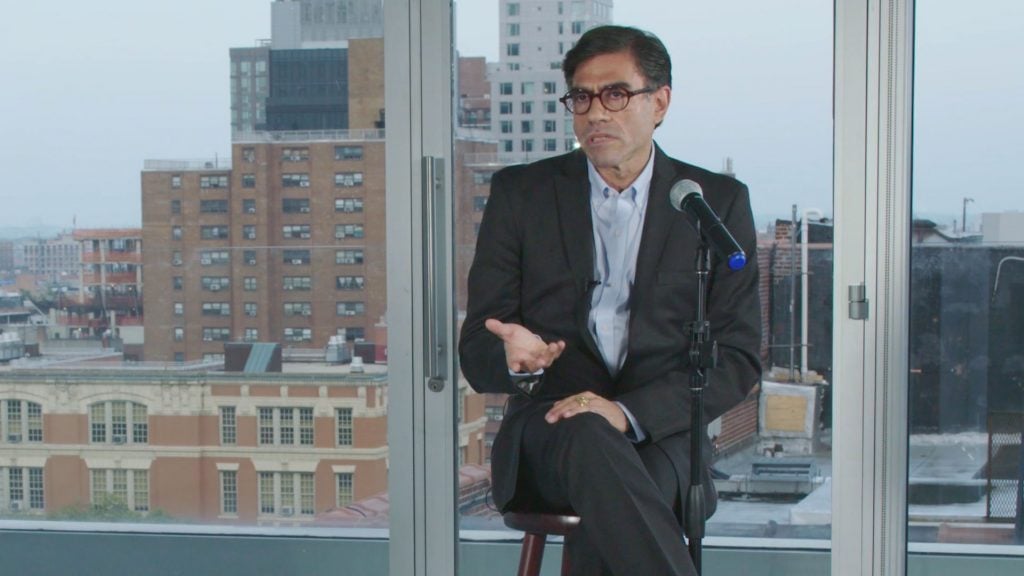
Only Idiots Smile (2017) is a 22-minute film by Gregg Bordowitz in which he addresses various aspects of his many identities. Courtesy the artist and Video Data Bank at the School of the Art Institute of Chicago.
“Gregg Bordowitz: I Wanna Be Well” is on view at MoMA PS1, 22–25 Jackson Avenue, Queens, New York, through October 11, 2021.